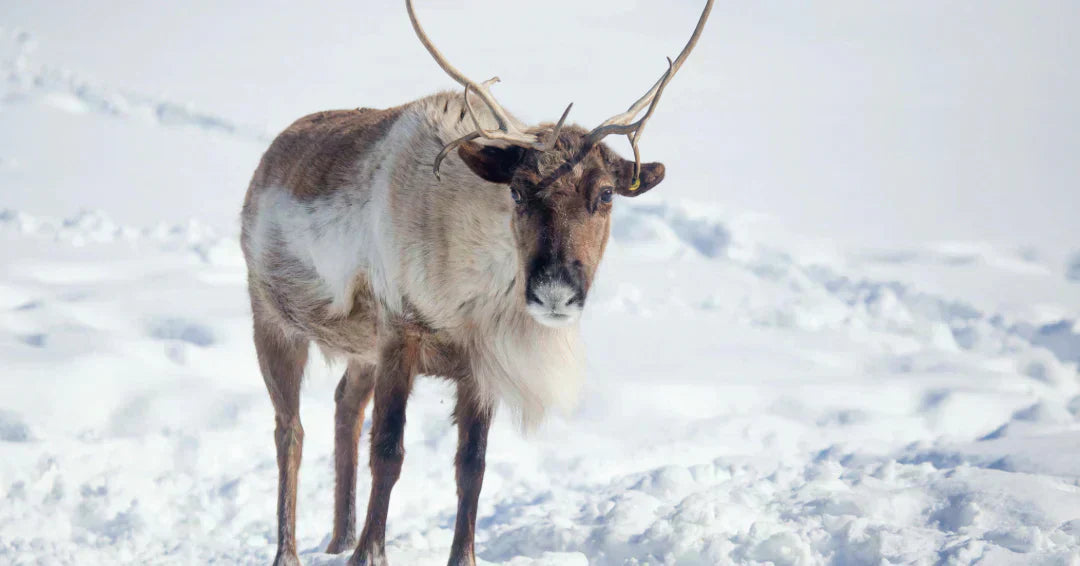If you ask children what they know about reindeer, chances are they will refer to what they know about the special team that is responsible for flying Santa around the world. They may start singing the famous song about the most famous of all with the glowing, red nose. Kids who want to expand their knowledge beyond the storybook version will enjoy reading these intriguing facts about reindeer.

Information About Reindeer for Kids
Kids will be interested to learn that reindeer are actually real! These animals are portrayed as magical creatures flying through the sky in children's books about reindeer. Iconic movies like Rudolph the Red-Nosed Reindeer have enthralled generations of children who have learned a lot of valuable life lessons about friendship and teamwork. Little ones will be amazed to discover more about the real animals that are the inspiration for Santa's crew. Here are some pretty cool facts about reindeer that stir the minds of curious kids, including what they eat, how they behave, where they live, and other information.
Anatomy of Reindeer
Reindeer, also known as caribou in North America, are incredible animals uniquely adapted to survive harsh Arctic and sub-Arctic conditions. Both male and female reindeer grow antlers, a rare trait among deer species. Their broad, flat, two-toed hooves are perfectly suited for navigating snowy and marshy terrains. Furthermore, an exceptionally dense, double-layered coat provides superior insulation. These remarkable features showcase the reindeer's amazing evolutionary journey, allowing them to flourish in some of the world's most challenging environments.

(1) Reindeer do have red noses.
Thermal cameras have captured the phenomenon of noses taking on a reddish color in very cold climates. Veins circulate blood around their noses which warms up the air they breath in so they don't get too cold. This is particularly important in maintaining the brain function, which would deteriorate if exposed to extremely cold air. Animals that live in Arctic regions, like Russia, Scandinavia, Greenland, Alaska and Canada, have all been identified as true red-nosed reindeer. For scientific-minded kids, the formal name of this species is Rangifer tarandus.
(2) All antlers are unique.
Just like snowflakes and fingerprints, no two antlers are alike. Both male and female reindeer have them, unlike other deer species where only males grow antlers. The size of these antlers does vary depending on the sex. Antlers on female reindeer have measured up to 20 inches while male antlers can reach in excess of 50 inches long. In terms of antler to body weight ratio, reindeer have the heaviest burden to bear compared to other species.
(3) Their eyes change color depending on the season.
An incredible feature is the way reindeer adapt based on significant seasonal changes in light in the Arctic. This visual phenomenon is a critical part of their survival in regions with harsh conditions. During the summer months when temperatures are more moderate, reindeer eyes are a beautiful golden color. But when the extreme cold arrives, their eyes change to a blue tone, amplifying the low light of the polar winters. By doing so, they can more easily spot predators and find scarce food sources.

Types of Reindeer Species
While all reindeer and caribou are the same species (Rangifer tarandus), they come in various types. These differences—in subspecies and ecotypes—are shaped by where they live, what they look like, and how they behave, especially their migration habits.

(4) Caribou and reindeer are one and the same species.
In North America, they are most commonly referred to as caribou while in Eurasia they are called reindeer. The species, however, is one and the same- Rangifer tarandus. The biggest differentiation is that caribou refers to animals that lively completely in the wild. Reindeer, on the other hand may be wild, semi-domesticated or fully domesticated, meaning that they are bred for a very specific reason.
(5) White reindeer are the rarest of all.
Leucistic reindeer, or sometimes incorrectly referred to as albino deer, are so rare that most don't even know they exist. In fact, they represent about 1% of the entire population. Their eyes and antlers are normal, but a genetic condition removes all pigmentation from their fur. Scandinavian countries associate them with good luck and happiness as do some indigenous cultures in northern Europe.

Why Reindeer Move in Herds
Reindeer are incredibly social creatures, renowned for their herding behavior. This natural tendency to form groups is vital for their survival in the harsh Arctic and sub-Arctic environments. These dynamic herds act as essential social units, enabling these resilient animals to overcome the challenges of their habitat, from locating food across vast, snowy terrains to fending off dangerous predators.

(6) No herd is too big.
Reindeer typically travel in herds ranging in size from 10 to a few hundred. Super-herds have been spotted with as many as 500,000 reindeer. They are extremely social in nature, staying in close proximity while eating, traveling, and resting. One of the primary reasons they stick together is to defend themselves from predators. With many eyes keeping watch, it is easier to spot a threat, especially as they migrate thousands of miles in search for food.
(7) Reindeer herding is an important part of the culture in many countries.
China, Russia, Mongolia, Norway, Finland, and Sweden are among the countries with an ancient culture rooted in herding reindeer. In fact, humans all over the world have hunted reindeer for their meat, fur, and milk for centuries. Antlers were also a valuable part of their bodies, as they could be turned into useful weapons or tools. Today, reindeer are commonly hunted for recreational purposes or to control a population that is overrunning a particular area.
What Reindeer Eat
Reindeer have a remarkably diverse diet that shifts dramatically with the seasons, enabling them to flourish in environments where food availability constantly fluctuates. As ruminants with a specialized digestive system, they expertly extract nutrients from a wide array of plants. Their diet is truly a masterclass in seasonal adaptation, allowing them to draw sustenance from the challenging, yet surprisingly varied, Arctic and sub-Arctic plant life.

(8) They like their vegetables.
The average adult reindeer consumes between 9 and 18 pounds of vegetation every single day. What they eat varies depending on the season and availability of plants in their region. For instance, during winter months, they use their hooves to scrape away snow in search of fungi and lichen, also called reindeer moss. When temperatures warm enough to melt the snow, there is a plethora of vegetation from which they can snack upon. These animals love various grasses, herbs, mosses, ferns, and shoots from plant and trees.
(9) Reindeer actually do not like carrots.
Kids will be disappointed to learn that the carrots they leave out, next to a plate of cookies for Santa, are not really an optimal snack. They lack a top row of teeth, so there is no way for them to chew the carrots down to small enough pieces for digestion. Also, carrots do not grow in Arctic regions, so these animals would find the food both unfamiliar and unappetizing. Despite the vitamins and minerals that would give them a boost of energy, a better choice would be a plate of grasses, seeds, alfalfa hay, raisins, and some diced apples.









